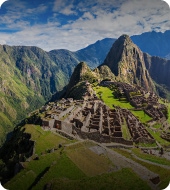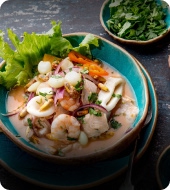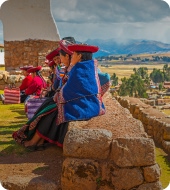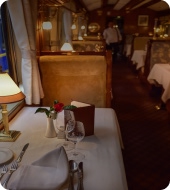
Ceviche: Peru’s UNESCO Heritage Dish!
Written by:Valencia Travel
Last Update: 2025-06-25
Ceviche, a dish of fresh fish cured in citrus juices and spiced with chili peppers, is not just a meal in Peru; it is the cornerstone of cultural identity. Recognized as an Intangible Cultural Heritage by UNESCO, ceviche represents the fusion of indigenous, African, and European culinary traditions that define Peruvian gastronomy. UNESCO (the United Nations Educational, Scientific and Cultural Organization) names heritage elements to its list of Intangible Cultural Heritage of Humanity every year to raise awareness of the importance of the historical practices and help to keep traditions alive. Beyond its delicious flavors, ceviche embodies the history, diversity, and creativity of the Peruvian people, and what better way to immerse yourself in local culture than on culinary tours in Peru?

Ceviche in Ecuador
The Origins of Ceviche - Historical Roots.
The origins of ceviche can be traced back to pre-Columbian Peru, where fish was marinated in chicha, a fermented maize beer. National Geographic describes how ceviche likely originated 3,000 years ago on the northern coast of what is now Peru, near a town called Huanchaco. The original recipes of the pre-Incan Moche people were likely quite different from today’s. A key ceviche ingredient—limes—only arrived in South America about 500 years ago, brought from Asia by the Spanish and Portuguese. In the absence of lime, there’s debate whether the fish in the original dish was combined with seaweed and chili peppers or perhaps with the juice of the passionfruit-like tumbo. The first published ceviche recipe might be from Lima writer Manuel Atanasio Fuentes in 1866. With the arrival of Spanish conquistadors in the 16th century, limes replaced chicha, introducing the acidic marinade that defines modern ceviche. African slaves brought to Peru also contributed to its evolution, adding ingredients like onions and sweet potatoes.

Seafood Ceviche in The Amazon
Ceviche’s Cultural Importance.
Ceviche is more than just a plate of food; it is a symbol of national pride and culinary innovation in Peru. It represents Peru's diverse cultural heritage, blending indigenous techniques with European and African ingredients. Ceviche showcases the bounty of the Pacific Ocean, highlighting the importance of sustainable fishing practices in Peruvian coastal communities. UNESCO highlighted the role of the dish in Peru’s cultural identity, the importance of artisanal sustainable fishers and traditional female ceviche cooks in cevicherías, regional variations of the dish, and how the knowledge of ingredients and techniques are passed down through families in Peru.
Ceviche and Peru’s Food Tourism.
Ceviche plays a significant role in Peru's gastronomic tourism, attracting food enthusiasts from around the world. Travelers flock to coastal cities like Lima, Trujillo, and Piura to savor the freshest ceviche prepared by skilled chefs. Food tours and cooking classes offer visitors the chance to learn about the history and preparation of ceviche, providing a deeper understanding of Peruvian culture. So why not take part in a Lima gastronomic tour to learn more about Peru´s national dish on your arrival to the country?

Ceviche in Cusco
Evolving Ceviche in Modern Cuisine.
While traditional ceviche remains a staple, Peruvian chefs are constantly innovating, creating new variations and interpretations of the dish. Ingredients like mango, avocado, and quinoa are being incorporated into ceviche, adding unique flavors and textures. These innovations highlight Peru's dynamic culinary scene and its commitment to preserving and evolving its culinary traditions.
Keeping Ceviche Traditions Alive.
Despite its global popularity, the essence of ceviche lies in its simplicity and tradition. Peruvian chefs and culinary experts are dedicated to preserving the authenticity of ceviche, using fresh, locally sourced ingredients and traditional techniques. This commitment ensures that ceviche remains a cherished part of Peru's cultural heritage for generations to come and a highlight of any Peru culture tour.

Ceviche and Pisco Sour
Peru’s Ceviche Culture and Tradition.
Ceviche (also spelled as “cebiche” and “seviche”) is so beloved in Peru that it celebrates it´s own national day on the 28th day of June, called Dia del Cebiche. Ceviche is eaten daily throughout Peru, in coastal cities like Lima, in the Amazonian jungle, and even in the Andean highlands near the country’s most famous tourist site, Machu Picchu.
Why Try Ceviche on Your Peru Adventure?
Ceviche offers a unique culinary experience that allows you to immerse yourself in Peru's rich cultural heritage. It's a chance to taste the flavors of history and tradition, all while exploring the vibrant gastronomic scene of Peru.
Where to Enjoy Ceviche in Peru - Itinerary Options:
Lima Gastronomic Tour: Explore the bustling markets of Lima, sample different varieties of ceviche, and learn about the history and preparation of this iconic dish.
Coastal Ceviche Adventure: Travel along Peru's coast, stopping in various cities to taste regional variations of ceviche and discover the local culinary traditions.
Cooking Class Experience: Join a hands-on cooking class to learn how to prepare authentic ceviche from expert chefs, using fresh, local ingredients. A highlight of culinary tours, Peru.
Each option offers a unique perspective on ceviche and Peruvian cuisine. The Lima Culinary Tour focuses on the history and culture of ceviche, while the Coastal Ceviche Adventure provides a broader culinary experience along Peru's coast. The Cooking Class Experience allows you to learn the art of ceviche preparation from local experts.

Your Ceviche is Served!
Points of View of Passengers on A Peru Culture Tour
"The ceviche in Peru is like nothing I've ever tasted before! The freshness of the fish and the tangy citrus marinade are just incredible." - Traveler, TripAdvisor.
"I never knew there were so many different types of ceviche until I took the Lima gastronomic tour. Each region has its own unique twist on this classic dish." - Food Enthusiast, Trip Advisor.
"A fantastic experience. Chef Andres was very knowledgeable, professional, friendly, and an excellent teacher!! Andres's teaching ability is phenomenal. He was able to simplify cooking concepts, and I was able to master them. I highly recommend this class if you would like to learn Peruvian cuisine, especially ceviche!" -Jonte L, Trip Advisor
When to Do the Trip to enjoy a ceviche?
The best time to enjoy a ceviche adventure in Peru is during the summer months (December to February) when the weather is warm and sunny. However, ceviche is available year-round and can be enjoyed at any time. Locals will tell you not to eat it after 5pm, however!
Can You DIY This Trip?
Yes, it is possible to design your own ceviche adventure in Peru. However, for the best experience and to ensure your safety, it's recommended to book through a reputable tour operator like Valencia Travel on a Peru culture tour that complies with all legal requirements. DYI travelers should be aware of the risks associated with food safety and transportation.
What to Consider For Peru Culture Travel
When choosing a ceviche adventure, consider the reputation of the tour operator, the variety of ceviche experiences offered, and the cultural immersion opportunities available. It's also essential to consider your dietary preferences and any food allergies.

Classic ceviche
How to Get to Lima -Ceviche Capital
Lima, the capital of Peru, is well-connected by air to major cities around the world. Jorge Chávez International Airport is the main gateway to Peru and is located in Callao, just outside Lima.
Must-Have Packing List for This Trip
Lightweight clothing for warm weather
Sunscreen and sunglasses
Comfortable walking shoes
Personal toiletries
Camera or smartphone for capturing memories.
How to Prepare For A Peru Culture Tour
Before your ceviche adventure, familiarize yourself with Peruvian cuisine and culture. Learn about the history of ceviche and its regional variations. It's also a good idea to brush up on basic Spanish phrases to enhance your experience, however, our guides all speak English too.
Pro Tips During This Trip:
Try different types of ceviche to experience the diversity of flavors.
Don't be afraid to ask locals for recommendations on where to find the best ceviche.
Be open to trying new ingredients and flavors, as ceviche is a dish that lends itself to creativity.
How Much Does It Cost?
The cost of a ceviche adventure in Peru can vary depending on the duration, inclusions, and level of luxury. On average, expect to pay between $50 and $200 per day per person, including accommodations, meals, and culinary tours. If you want to simply try ceviche in a restaurant, you should expect to pay anywhere between $10 USD and $30 USD

Colorful Cuisine
Frequently Asked Questions About Ceviche:
Q: Is it safe to eat ceviche in Peru?
A: Yes, as long as it is prepared with fresh, high-quality ingredients and from a reputable establishment.
Q: Can I learn how to make ceviche during my trip?
A: Yes, many tours and cooking classes offer the opportunity to learn how to make ceviche from local chefs.
Q: Are there vegetarian or vegan options for ceviche?
A: Yes, some restaurants offer vegetarian or vegan versions of ceviche, using ingredients like mushrooms or hearts of palm as a substitute for fish.

Simply Ceviche!
Ceviche is more than just a dish; it is a reflection of Peru's rich cultural heritage and culinary excellence. Its recognition as an Intangible Cultural Heritage by UNESCO underscores its importance as a symbol of national identity and culinary innovation. Whether enjoyed on the streets of Lima or in a high-end restaurant, ceviche continues to captivate the hearts and palates of people around the world, showcasing Peru's vibrant culture and gastronomic heritage. Ask us about our culinary tours in Peru and Lima gastronomic tours on your Peru culture travel escapades!

A Seafood Sensation!
 Aventure
Aventure
 Cultural
Cultural
 Gastronomy
Gastronomy
 Wellness
Wellness
 Local Living
Local Living
 Luxury
Luxury







